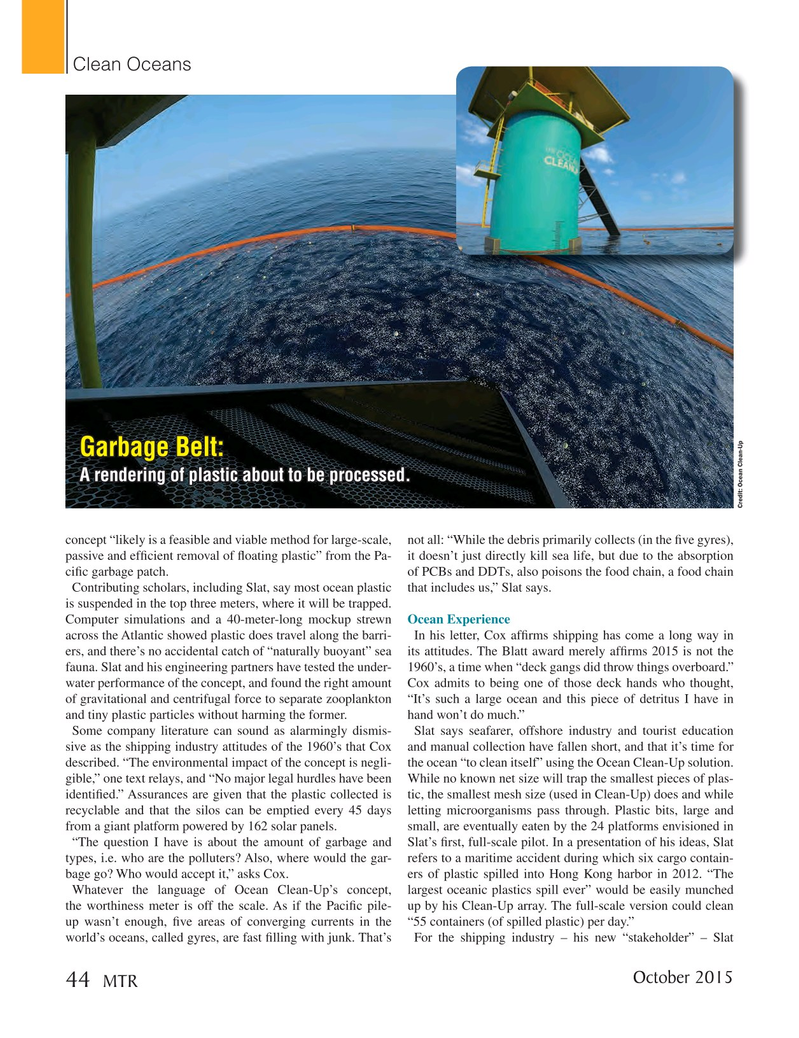
Page 44: of Marine Technology Magazine (October 2015)
AUV Operations
Read this page in Pdf, Flash or Html5 edition of October 2015 Marine Technology Magazine
Clean Oceans
Garbage Belt:
A rendering of plastic about to be processed.
Credit: Ocean Clean-Up concept “likely is a feasible and viable method for large-scale, not all: “While the debris primarily collects (in the ? ve gyres), passive and ef? cient removal of ? oating plastic” from the Pa- it doesn’t just directly kill sea life, but due to the absorption ci? c garbage patch. of PCBs and DDTs, also poisons the food chain, a food chain
Contributing scholars, including Slat, say most ocean plastic that includes us,” Slat says.
is suspended in the top three meters, where it will be trapped.
Computer simulations and a 40-meter-long mockup strewn Ocean Experience across the Atlantic showed plastic does travel along the barri- In his letter, Cox af? rms shipping has come a long way in ers, and there’s no accidental catch of “naturally buoyant” sea its attitudes. The Blatt award merely af? rms 2015 is not the fauna. Slat and his engineering partners have tested the under- 1960’s, a time when “deck gangs did throw things overboard.” water performance of the concept, and found the right amount Cox admits to being one of those deck hands who thought, of gravitational and centrifugal force to separate zooplankton “It’s such a large ocean and this piece of detritus I have in and tiny plastic particles without harming the former. hand won’t do much.”
Some company literature can sound as alarmingly dismis- Slat says seafarer, offshore industry and tourist education sive as the shipping industry attitudes of the 1960’s that Cox and manual collection have fallen short, and that it’s time for described. “The environmental impact of the concept is negli- the ocean “to clean itself” using the Ocean Clean-Up solution. gible,” one text relays, and “No major legal hurdles have been While no known net size will trap the smallest pieces of plas- identi? ed.” Assurances are given that the plastic collected is tic, the smallest mesh size (used in Clean-Up) does and while recyclable and that the silos can be emptied every 45 days letting microorganisms pass through. Plastic bits, large and from a giant platform powered by 162 solar panels. small, are eventually eaten by the 24 platforms envisioned in “The question I have is about the amount of garbage and Slat’s ? rst, full-scale pilot. In a presentation of his ideas, Slat types, i.e. who are the polluters? Also, where would the gar- refers to a maritime accident during which six cargo contain- bage go? Who would accept it,” asks Cox. ers of plastic spilled into Hong Kong harbor in 2012. “The
Whatever the language of Ocean Clean-Up’s concept, largest oceanic plastics spill ever” would be easily munched the worthiness meter is off the scale. As if the Paci? c pile- up by his Clean-Up array. The full-scale version could clean up wasn’t enough, ? ve areas of converging currents in the “55 containers (of spilled plastic) per day.” world’s oceans, called gyres, are fast ? lling with junk. That’s For the shipping industry – his new “stakeholder” – Slat
October 2015 44
MTR
MTR #8 (34-49).indd 44 9/29/2015 2:55:18 PM

 43
43

 45
45
